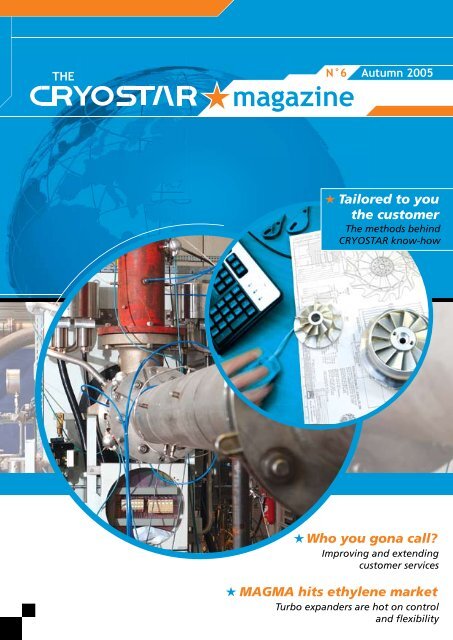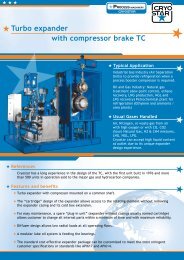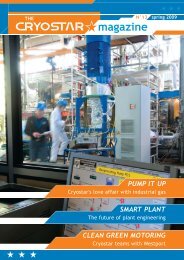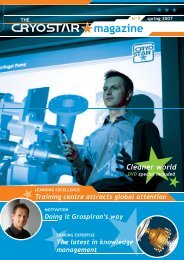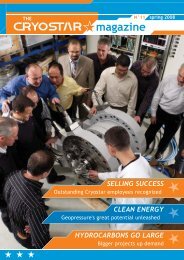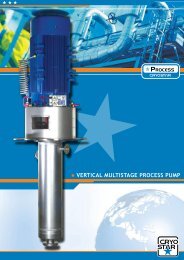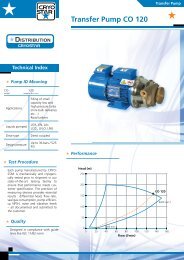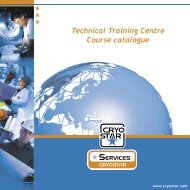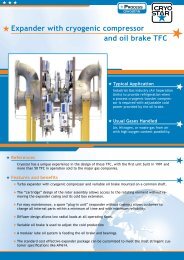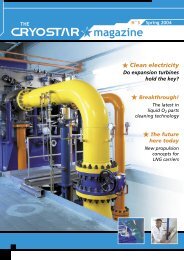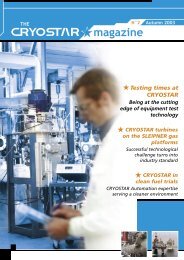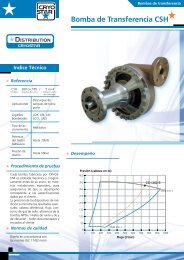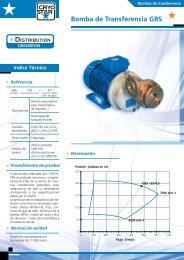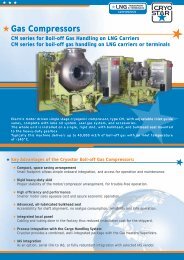The Cryostar Magazine N°6 : pdf file
The Cryostar Magazine N°6 : pdf file
The Cryostar Magazine N°6 : pdf file
Create successful ePaper yourself
Turn your PDF publications into a flip-book with our unique Google optimized e-Paper software.
N°6<br />
Autumn 2005<br />
Tailored to you<br />
the customer<br />
<strong>The</strong> methods behind<br />
CRYOSTAR know-how<br />
Who you gona call?<br />
Improving and extending<br />
customer services<br />
MAGMA hits ethylene market<br />
Turbo expanders are hot on control<br />
and flexibility
EDITO<br />
Customer service is the very life-blood of CRYOSTAR. It encompasses everything from<br />
before to after-sales service. Above all it reflects CRYOSTAR’s determination to work with<br />
customers, delivering what they want when they want it, to the highest international<br />
standards.<br />
One aspect of CRYOSTAR customer service is the technological innovations behind our<br />
products. In every market, in all geographies, CRYOSTAR technology provides our customers<br />
with a competitive edge.<br />
CRYOSTAR is at the forefront of cryogenic technology – more than 40 years studying the<br />
art of cryogenics has led to a multitude of innovative solutions, new applications and<br />
technological improvements.<br />
Be it pumps, automation, turbines, expanders or LNG shipboard equipment, CRYOSTAR<br />
continues to invest in research and development. Never a day goes by without our engineers<br />
pushing the boundaries in one field or another.<br />
In recent times we have brought to the market the MTC; the GBSD transport pump range;<br />
the Modular Reciprocating Pump; the power recovery turbine; turnkey LNG / biogas<br />
installations; fuelling and filling stations; hydrogen related cryogenic equipment... and the<br />
list goes on.<br />
In this edition of CRYOSTAR magazine we continue to highlight the latest advances in<br />
technology and in Tailored to you, the customer, page 3, we provide some insight into how<br />
our business operates.<br />
At CRYOSTAR we believe in innovation, service, research and development, working in<br />
partnership with customers. In the many markets in which our customers operate,<br />
competition is keen and demands are constantly changing.<br />
CRYOSTAR recognises this, which is why we put so much effort into improving technology,<br />
improving our service offerings. It’s what makes CRYOSTAR a market leader.<br />
We are committed to the pursuit of innovative technology, committed to meeting our<br />
customers’ needs, any time, any place. CRYOSTAR technology is the jewel in many a customer<br />
crown and we’re proud of that.<br />
Daniel MEYER<br />
President<br />
Tailored to you, the customer ............. p 3<br />
<strong>Cryostar</strong> gets its MAGMA turbo expanders in ethylene market ............. p 5<br />
Everyone’s a winner with us ............. p 7<br />
Controlling the process ............. p 8<br />
News ............. p 9<br />
Who you gonna call? ............. p 10<br />
Events ............. p 11<br />
Tools and datas ............. p 11<br />
<br />
Autumn 2005
Tailored to you, the customer<br />
Thousands of engineering solutions for hundreds of<br />
companies – <strong>Cryostar</strong> know-how, a jewel in many a<br />
customer’s crown...<br />
Four hundred different centrifugal and reciprocating cryogenic pump<br />
models, more than fifty different turbo machine frame sizes and<br />
thousands of precisely engineered designs – all to meet the needs of<br />
the cryogenic and atmospheric and hydrocarbon gases industries. For<br />
40 years <strong>Cryostar</strong> has been developing custom-made, designed and<br />
engineered products and machinery.<br />
But what is that makes <strong>Cryostar</strong> tick? Well, there is the ‘developments’<br />
side, which can be split into three major platforms: machinery, applications<br />
and process. Machinery is driven by individual customer<br />
and general market demand, and is based on existing machines and<br />
<strong>Cryostar</strong> expertise. Applications are derived from working closely<br />
with customers to help them further exploit <strong>Cryostar</strong> products.<br />
Process, on the other hand, is very much internal, with <strong>Cryostar</strong><br />
research and development engineers working with frontline staff to<br />
ensure the delivery of products to exacting international standards.<br />
This way the best process and most efficient machine can be developed<br />
for the market and customer fast.<br />
However, ‘developments’ can also be categorised as ‘on the job’ and<br />
‘off the job’. ‘On the job’ is usually reserved for those large machines,<br />
which are extensions of the <strong>Cryostar</strong> product portfolio. ‘Off the job’ is<br />
predominantly for products later sold in quantity, like small cryogenic<br />
pumps or turbines, usually developed without a specific order but with<br />
an eye on future customer needs.<br />
Development cycles<br />
Products that come under ‘on the job’ are developed and built during<br />
the normal contract and commercial cycle, and delivery times are<br />
dictated by the competitive situation.<br />
During such developments, which are usually done by <strong>Cryostar</strong> engineers,<br />
there are extensive design reviews and additional calculation<br />
cycles with the possible inclusion external consultants. An extensive<br />
in-house testing period follows completion. Importantly, the customer<br />
can also be involved in the assessment cycle. This is because design<br />
validation testing must fulfil predetermined test criteria to gain customer<br />
sign-off. <strong>Cryostar</strong>’s inherent attention to detail also means its<br />
development engineers are involved in the commissioning and start up<br />
of a new machine.<br />
Autumn 2005
CUSTOMERS<br />
In case of the ‘off the job’ developments, the design<br />
and production will undergo same cycles, but<br />
without the customer involvement and typically<br />
without any major time constraints. More important<br />
is the extensive and long-term in-house testing<br />
of a new product, to demonstrate suitability and<br />
performance levels to the market. <strong>The</strong> new product<br />
is launched only if the extensive testing shows it<br />
fulfils or supersedes expectations. In many cases<br />
this also includes extended testing at selected customer<br />
sites prior making it generally available.<br />
<strong>The</strong> test tools<br />
As well as development validation <strong>Cryostar</strong> also<br />
has performance testing capabilities. In Hésingue,<br />
the company has two large test facilities, one for<br />
cryogenic pumps and the other for turbo machines.<br />
In Capdenac, <strong>Cryostar</strong> Automation test facility<br />
allows for complete filling stations and control<br />
systems to be fully tested. All are equipped with<br />
automated data acquisition systems.<br />
<strong>The</strong> test facility for pumps includes two liquid nitrogen<br />
vacuum insulated cryogenic tanks with five<br />
different metering test lines. Reciprocating pumps<br />
up to 600 bars and 100 l/min, and centrifugal<br />
pumps for up to 100 bars at flows up to 14’000<br />
l/min, can be tested using liquid nitrogen. This<br />
cryogenic test facility is the largest of its kind for<br />
industrial gases pumps in the world.<br />
<strong>The</strong> turbo machines test facility has a test space for<br />
simultaneous preparation and sequential testing of<br />
four low-duty compressors and for four high-duty<br />
compressors for LNG carriers (two ship sets) at 60<br />
Hz and any voltage up to 6’600 Volts. <strong>The</strong> third<br />
set of compressors can be under preparation, while<br />
the forth can be at the completion stage after the<br />
testing.<br />
In addition, up to six turbo expanders can be located<br />
in the test hall for testing with pressurized<br />
air. <strong>The</strong> today’s volumes are in the order of 160<br />
LNG carriers’ shipboard compressors and around<br />
100 turbo expanders per year. This can be extended<br />
easily by staff working in tailored shift patterns.<br />
People and Expertise<br />
And that is why the backbone of <strong>Cryostar</strong> is its staff<br />
of almost 300. <strong>The</strong>re are engineers with bachelor,<br />
master or even higher (PhD) degrees. Through internal<br />
training courses and know-how transfer from<br />
more experienced colleagues <strong>Cryostar</strong> continues to<br />
strengthen its capabilities. Staff development is a<br />
priority and <strong>Cryostar</strong> invests close to three per cent<br />
of its annual turn over in training with a larger part<br />
dedicated to engineering and development staff.<br />
This type of investment in people allows <strong>Cryostar</strong><br />
to tackle and deliver solutions to varied and often<br />
complex customer problems. Not only does it have<br />
extensive cryogenic know-how and aerodynamic<br />
and hydraulic design expertise to call on, but 35<br />
years in this specialist market has armed the company<br />
with expertise in many other areas.<br />
<strong>The</strong>y include: materials at cryogenic temperatures,<br />
stress analysis, heat transfer, cryogenic vaporisation<br />
and condensation together with other unit<br />
operations, oxygen compatibility of materials,<br />
and pressure containment design for extreme pressures.<br />
Coupled with these are a multitude of specialist<br />
tools, including: CAD for the design of turbo<br />
machines and pumps; CFD software for flow and<br />
pressure distribution analysis in turbo machines<br />
and pumps; and FEA software for wheel blades<br />
resonance and for stress and displacement calculations,<br />
to name but a few.<br />
For very specific tasks like rotor dynamics and rotor<br />
vibration behavior, aerodynamics and hydraulic<br />
design and analysis, external consultants can be<br />
brought in for independent evaluations.<br />
All these disciplines combine to form the basis of<br />
<strong>Cryostar</strong>’s technological and commercial success.<br />
In other words, it’s what makes the company tick.<br />
<strong>The</strong> technological testing during the production cycle (hydro<br />
testing, gas leak testing, balancing, over speed testing, holographic<br />
blade resonance testing, etc.) will be the subject of a<br />
future article.<br />
<br />
Autumn 2005
TECHNOLOGY<br />
<strong>Cryostar</strong> gets its MAGMA<br />
turbo expanders in ethylene market<br />
For ethylene plant owners, <strong>Cryostar</strong> has designed and<br />
built a dual turbo expander compressor (2-MTC)<br />
solution that provides safety, ease of control and flexibility.<br />
Both low pressure (LP) and high pressure (HP) units<br />
are mounted on the same skid, with explosion-proof<br />
instruments. <strong>The</strong> units are equipped with active<br />
magnetic bearings and controlled through a <strong>Cryostar</strong>programmed<br />
Programmable Logic Controller.<br />
Two expanders in series expand the off-gas fluid,<br />
with braking power being provided by compressor<br />
wheels mounted on the same shaft. Both units rotate<br />
at the same high speed to maximise the expanders’<br />
efficiency.<br />
Magnetic bearings provide a 100 per cent leak-safe design,<br />
avoiding any risk of oil ingestion into the process<br />
gas. Both LP and HP expanders can be independently<br />
by-passed by the process gas. <strong>The</strong>refore, either the LP<br />
or the HP machine can be operated as a single unit.<br />
This feature enhances process flexibility.<br />
At the root of this achievement is a state-of-the-art<br />
design process for wheels and shafts. <strong>The</strong> gas to be expanded<br />
combines a low molecular weight (less than 5<br />
kg/kmol) and a high massflow (more than 1000 kmol/<br />
hr). <strong>The</strong> low molecular weight requires extremely high<br />
tip speed of the wheels for optimum efficiency.<br />
For a price-competitive solution, <strong>Cryostar</strong> opted for<br />
two machines belonging to the MTC200 frame size.<br />
MTC200 are magnetic bearings turbines braked by a<br />
compressor wheel, with an expander wheel diameter of<br />
nominally 200mm. For both HP and LP machines, the<br />
expander wheel is made of a high strength aluminium<br />
alloy and the diameter is 210mm. Compressor wheels<br />
are made of the same material with a 220mm diameter.<br />
All are milled from solid. This straightforward<br />
design solution as described bellow eliminates any risk<br />
of wheel cracking by blade resonances.<br />
High speed rotor development<br />
Prior to rotordynamics investigations, the natural<br />
resonance of the wheels must be calculated. <strong>The</strong><br />
modal analysis of expanders and compressor wheels<br />
showed no risk of resonance in the range of operating<br />
speeds. This assessment was performed using Finite<br />
Element Analysis (FEA). Once optimised, geometries<br />
of the wheels were fed into models representing full<br />
rotors, to be used for the rotordynamics analysis.<br />
Due to the high maximum continuous rotating<br />
speed close to 40,000 rpm, and the relatively large<br />
wheels for MTC200 machine frame size, the new<br />
rotor design was a challenge that <strong>Cryostar</strong> experts<br />
were eager to face. Actually, with respect to the lateral<br />
critical speed analysis (LCSA), several iterations<br />
were needed to meet the API acceptance criteria.<br />
Autumn 2005
TECHNOLOGY<br />
<strong>The</strong> LCSA aims to defining rotor<br />
natural frequencies associated<br />
with structural deflections of the<br />
rotor. Natural frequencies are<br />
converted into rotating speed<br />
values called critical speeds.<br />
All structures possess natural<br />
frequencies at which they vibrate<br />
most violently when struck. For a<br />
rotor, a state of resonance can be<br />
reached if the rotation frequency<br />
equals one of the rotor natural<br />
frequencies. This phenomenon<br />
leads to deformations, which can<br />
severely damage the structure.<br />
With regard to LCSA, API 617<br />
standards require that either the<br />
deflection of the structure is low<br />
enough or that the difference<br />
between the maximum continuous<br />
speed and the first critical speed<br />
is high enough (see “Technical<br />
data panel for accurate criteria”).<br />
<strong>The</strong> LCSA enabled <strong>Cryostar</strong> to<br />
find the appropriate rotor for a<br />
resonance-free design. Iterative<br />
refinements of detailed design<br />
features were carried out in close<br />
co-operation with S2M, the<br />
magnetic bearing supplier. API<br />
acceptance criteria were met<br />
with a remaining safety margin.<br />
High-tech design methods,<br />
combined with pragmatic<br />
targets, resulted in a smart<br />
and robust solution.<br />
*<strong>The</strong> first two-stage <strong>Cryostar</strong><br />
MAGMA turbo expander 2-MTC<br />
of this high speed configuration<br />
was designed and built for cold<br />
production in a new ethylene plant<br />
in Qatar.<br />
Technical data<br />
Vibration level<br />
<strong>The</strong> amount of expected deflection of the rotor is quantified by API standards<br />
with the amplification factor AF (<strong>The</strong> higher the Amplification Factor,<br />
the sharper the deflection peak):<br />
N c1 : Critical speed corresponding to the maximum deflection<br />
N 1 and N 2 : Lesser and greater speeds at 0.707 x peak deflection (<strong>The</strong> peak deflection is at critical<br />
speed Nc1)<br />
<strong>The</strong> difference between the maximum continuous speed and the first critical<br />
speed is quantified by API standards with the separation margin SM, defined<br />
as follows when the critical speed is greater than the maximum continuous<br />
speed:<br />
Nmc: Maximum continuous speed<br />
Depending on the AF value, the API 617 standards acceptance criteria is:<br />
1. If<br />
2. If ,<br />
in case of a critical speed higher than the maximum continuous speed.<br />
3. If ,<br />
Ac1<br />
0.707 peak<br />
N1<br />
CRE<br />
Nc1<br />
SM<br />
N2<br />
Operating speeds<br />
Revolutions per minute<br />
in case of a critical speed lower than the minimum speed (not applicable to the developed case).<br />
Nmc<br />
SM<br />
CRE<br />
Ncn<br />
<br />
Autumn 2005
WINNER<br />
Everyone’s a winner with us<br />
Mahmood Javed, R&D Manager at Abdullah Hashim<br />
Gas in Saudi Arabia, visited the <strong>Cryostar</strong> headquarters<br />
in Hésingue, France on 29 April with his wife, as part<br />
of his prize for winning the <strong>Cryostar</strong> Middle East<br />
Competition in February this year.<br />
His visit began with the presentation of a souvenir<br />
<strong>Cryostar</strong> photo album along with a few words of congratulations<br />
from Daniel Meyer, <strong>Cryostar</strong>’s President.<br />
This was followed by a slide show on the company and<br />
a tour of the site with Philippe Fauvel, Sales Manager,<br />
South Europe and the Middle East.<br />
<strong>The</strong> tour started in the main administration building<br />
which contains sales, purchasing and central management<br />
for the company. Although based in France, the<br />
headquarters is on the borders of both Germany and<br />
Switzerland, an important factor for a company which<br />
exports around 90 per cent of its products. “Even our<br />
employee base is multinational,” said Philippe. “We<br />
have over 230 people from 12 countries working at<br />
our French headquarters alone.”<br />
<strong>The</strong> tour also took in <strong>Cryostar</strong>’s research and development<br />
offices. “We have a team dedicated to R&D,”<br />
explained Frédéric Marcuccilli,<br />
R&D engineer. “And it is thanks<br />
to this team that we are able to<br />
develop and customise solutions<br />
to exact needs of individual customers.”<br />
At a cost of over 4 million Euros, <strong>Cryostar</strong>’s testing facilities<br />
represents a huge customer service investment.<br />
“We have the world’s most sophisticated test stand for<br />
pumps,” said Laurent Rapp, test stand manager, “Not<br />
only has it helped to expand our R&D programme<br />
but we also provide individual customised test reports.<br />
One hundred per cent of the material our customers<br />
buy is tested before delivery.”<br />
Final stop on the tour was the on-site maintenance<br />
shop and customer service department.<br />
Our winner expressed his hopes that the visit would<br />
be the start of a strong relationship between the two<br />
companies.<br />
<strong>The</strong> winner’s weekend continued with sight seeing<br />
trips around the region including Colmar, in Alsace,<br />
France, and the Black Forest in Germany.<br />
<strong>The</strong> Middle East Competition was a great success with<br />
triple the industry average in responses. It is hoped<br />
that the programme can now be expanded to other<br />
regions.<br />
At the assembly workshop,<br />
our winner was able to see first<br />
hand the construction of several<br />
product lines from the large LNG<br />
compressors to the vast range of<br />
world-leading <strong>Cryostar</strong> cryogenic<br />
pumps.<br />
“Mahmood was very impressed<br />
with the high quality of <strong>Cryostar</strong><br />
production tools and the commitment<br />
shown of all employees. Customer<br />
satisfaction is something we<br />
all focus on,” said Philippe.<br />
Autumn 2005
PROCESS CONTROL<br />
Controlling the process<br />
To meet rising customer expectation in the fast changing Programmable L o g i c<br />
C o ntroller ( P LC ) world, Cr yo s t a r m a ke s u s e of cut t i n g e d g e s o lutions...<br />
<strong>The</strong> escalating plant sizes are putting tremendous<br />
pressure on reliability and availability requirements<br />
to avoid any downtime or production loss. In addition,<br />
to reduce installation costs, less manpower<br />
is available on site, so reducing the manual activity<br />
to a minimum requires increased use of process<br />
automation.<br />
Since the beginning of the process industry, control<br />
systems have been required to meet ever-changing<br />
demands. So over the last few years, <strong>Cryostar</strong> has<br />
implemented many different PLC configurations<br />
to suit specific customer needs. <strong>The</strong> latest main<br />
developments are:<br />
started to replace the other safety related hardwired<br />
circuits.<br />
As state-of-the-art technology sets the trend<br />
towards application of best in class PLCs and as<br />
safety of people and environmental protection<br />
become more important, customers will reject<br />
lower integrity systems. This, together with the<br />
likelihood that safety integrated level requirements<br />
might be needed in the future, drives the use of the<br />
safety PLC.<br />
Redundancy<br />
In order to deal with increased demand on availability,<br />
PLC redundancy is implemented. It avoids<br />
disruption of the process in case of machine PLC<br />
failure. Different redundant configurations are<br />
possible. As a minimum, the power supply and the<br />
CPU are duplicated, where the second unit takes<br />
over the duty instantaneously in case the first fails,<br />
ensuring continuous machine operation.<br />
A further extension of redundancy can be the duplication<br />
of the inputs and outputs (e.g. an analogue<br />
4-20mA output signal is fed a half-signal by each of<br />
two output modules, and full-signal by one module<br />
in case the other fails). Detected instrument failures,<br />
resulting in the shutdown of machinery, also<br />
leads to a reduction in overall plant reliability and<br />
availability. So spurious ‘trips’ have to be avoided.<br />
This is done by triplication of selected sensors and<br />
by the implementation of a two-out-of-three voting<br />
(2oo3) so at least two sensors must detect the<br />
faulty situation in order to initiate a shutdown and<br />
the process continues in case of failure of a single<br />
sensor.<br />
Safety<br />
Safety systems have traditionally required hard wiring<br />
and the use of electro-mechanical components.<br />
Today, except for specific safety functions like the<br />
emergency shutdown, dedicated ‘Safety PLCs’ have<br />
<br />
Autumn 2005
PROCESS CONTROL<br />
Remote I/O<br />
To reduce site installation costs, PLC remote input/output (remote<br />
I/O) technology has been developed. This is where multiple hard-wired<br />
cables are replaced by a single or a redundant communication link.<br />
This technology has been around for some time, and since it is now<br />
field proven, its popularity has increased. It is now also certified for<br />
hazardous areas, even for Zone I (on shipboard applications the remote<br />
input/output is becoming standard equipment).<br />
Interfaces<br />
Data exchange with the different plant central controls, emergency<br />
shutdown or machine maintenance systems are done by serial communication<br />
links, with Modbus the preferred protocol.<br />
Flat panel displays with touch-screens are forcing the traditional lamp<br />
and push-button machine interfaces into the history books. <strong>The</strong> colour<br />
displays, showing machine mimics, on-line machine performance and<br />
operating conditions, are much more user friendly and able to provide<br />
more information.<br />
In conclusion, whether installed in hydrocarbon or industrial gas plants,<br />
<strong>Cryostar</strong>’s equipment is critical for plant operation. <strong>The</strong> availability<br />
requirement for this equipment remains high and customer expectations<br />
continue to rise. This applies, of course, to both the mechanical<br />
components and the control system, which is why <strong>Cryostar</strong> is at the<br />
cutting edge of technological changes and trends offering state-of-theart<br />
solutions to fulfil customers’ growing requirements.<br />
News<br />
Biggest turbo expanders ever built by <strong>Cryostar</strong><br />
<strong>The</strong> biggest turbo expanders ever built by <strong>Cryostar</strong> - 2 MTC<br />
600/240 for the Orman Lange (Norway) project - were successfully<br />
tested and shipped in September. <strong>The</strong> main characteristics<br />
of these huge machines are:<br />
- MTC 600/240 frame size going up to 12 MW<br />
- Largest magnetic bearings for high speed applications with<br />
diameter 240 mm<br />
- Compressor housing diameter 1600 mm and 100 bar design<br />
pressure.<br />
In testing the machines the following were used: six oil free<br />
screw compressors, diesel motor driven, with total 2,375 kW<br />
power and 16,000 m3/hr throughput in addition to the installed<br />
PGW 4 stage centrifugal compressor with 1250 kW<br />
electric motor and 11,000 m3/hr.<br />
Exhibition in China<br />
<strong>Cryostar</strong> attended the IG China exhibition in Hangzhou<br />
in September. A team from our Hangzhou office<br />
and a delegation of the <strong>Cryostar</strong> SAS (France)<br />
management team attended to present <strong>Cryostar</strong> and<br />
its solutions to the Chinese market. <strong>The</strong> response was<br />
excellent and many Chinese customers took the opportunity<br />
to discuss current and future projects.<br />
<strong>Cryostar</strong> USA East is moving<br />
We are pleased to announce that in order to meet<br />
growing demand in the US, <strong>Cryostar</strong> USA PA will<br />
move to a larger facility in Allenton, PA. <strong>The</strong> new facility<br />
enjoys a total of 750 square metres of shopfloor<br />
and office space. <strong>The</strong> new address is:<br />
5897 Colony Drive<br />
Bethlehem, PA 18017<br />
USA<br />
Autumn 2005
FOCUS ON ... THE CUSTOMER SERVICE DEPARTMENT<br />
Who you gonna call?<br />
<strong>Cryostar</strong>’s Customer Service Department (CSD)<br />
is dedicated to achieving and even surpassing the<br />
highest standards of service expected by all customers.<br />
“We are continually looking to improve and<br />
extend the services we provide,” said Didier Walch,<br />
Customer Service Director. “At <strong>Cryostar</strong> we want<br />
to grow our customer partnerships and develop in<br />
unison with the customer, to realise an enduring<br />
and mutually productive future together.”<br />
<strong>The</strong> CSD, based at the company headquarters in<br />
France, is currently staffed by more than 40 market<br />
and product service specialists, all dedicated to<br />
ensuring efficient, and customer focussed, before,<br />
during and after sales service.<br />
In fact, this central team manages all customer service<br />
activity around the world. <strong>The</strong> team develops<br />
all <strong>Cryostar</strong> standards, which are then duplicated<br />
across the company’s network of business centres<br />
and local agents, ensuring consistently high quality<br />
service on all five continents.<br />
But the network is not just a day-to-day support<br />
mechanism for customers, it represents a powerful<br />
combination of local solution providers able to<br />
tap into an international pool of experience and<br />
expertise.<br />
“Every <strong>Cryostar</strong> business centre maintains a 24-<br />
hour emergency telephone service and our engineers<br />
are available for call out at any time,” said Julien<br />
Rivello, Customer Service Operations Manager.<br />
Product reliability<br />
<strong>Cryostar</strong> understands the importance to customers<br />
of product reliability. As a result, dedicated maintenance<br />
shops and maintenance teams are based in<br />
France, the UK, China and the US.<br />
Expert support is equally available in other regions<br />
for start-ups, consulting, commissioning and onsite<br />
maintenance and audits.<br />
OEM guaranteed high quality parts, fully comprehensive<br />
parts kits, management of spare and wear<br />
parts and scheduled or emergency delivery times<br />
are another of the cornerstones on which <strong>Cryostar</strong>’s<br />
network meets the needs of customers. And so is<br />
the web-based spare parts supply portal which will<br />
soon be on-line, allowing contracted customers to<br />
order spares, check pricing and receive delivery<br />
confirmation.<br />
Adding value is another <strong>Cryostar</strong> cornerstone.<br />
<strong>The</strong> CSD does this by providing efficiency and/or<br />
lifetime improvements and retrofit upgrades of<br />
existing machines, often increasing running hours<br />
and creating important savings for our customers.<br />
Another aspect is fully customised training sessions<br />
for all <strong>Cryostar</strong> products and applications, using<br />
all the latest tools and technologies for learning.<br />
“Years of experience and expertise in the industry<br />
enables <strong>Cryostar</strong> to take on the full service element<br />
for the customer,” said Marc Runser, Applications<br />
and Customer Service Manager, Distribution products<br />
and services.<br />
“We can provide individual, innovative service<br />
agreements, customised to particular requirements,<br />
with a focus on providing peace of mind for the<br />
customer.<br />
“<strong>Cryostar</strong> maintenance agreements can include<br />
anything and everything, from the basic preventive<br />
maintenance of pumps and turbines, through to<br />
consulting, training, crane hire and repainting.”<br />
<strong>Cryostar</strong>’s Customer Service Department is all<br />
about customer care – so if you have a problem you<br />
know who to call.<br />
10<br />
Autumn 2005
EVENTS & TOOLS<br />
Events<br />
November, 2005<br />
Oil & Gas Exhibition 2005, Fiera<br />
Milano, Padiglioni 14, 15, 16,<br />
20145, Milano, Italy<br />
November, 2005<br />
IPPEX 2005, Nippon Convention<br />
Center, Nakase 2-1, Mihama-ku,<br />
Chiba City,261-0023, Japan<br />
February, 2006<br />
April, 25-29, 2006<br />
Welding Zagreb, Zagreb Fair,<br />
Avenija Dubrovnik 15, HR-10<br />
020 Zagreb, Croatia<br />
May, 23-26, 2006<br />
SVARKA - WELDING 2006,<br />
Lenexpo Fairgrounds, 103 Bolshoy<br />
Prospect; St. Petersburg,<br />
199106, Russia<br />
SOPEC 2006, Dhahran International<br />
Exhibition Centre,<br />
P.O.BOX 7519, Dammam 31472,<br />
Saudi Arabia<br />
Tools and datas:<br />
Combustion constants of Hydrocarbon Gases<br />
Heat of Combustion<br />
Pound per Pound of Combustible Gas<br />
BTU per Pound Required for Combustion Products of Combustion<br />
Name of gas<br />
Symbol<br />
Mol<br />
Weight<br />
Gross Net O 2 + N 2 = Air CO 2 H 2 P N 2<br />
Carbon (Solid) C 12.011 14,093 14,093 2.664 8.863 11.527 3.664 - 8.863<br />
Hydrogen H 2 2.016 61,100 51,623 7.937 26.407 34.344 - 8.937 26.407<br />
Carbon Monoxide<br />
CO 28.010 4347 4347 0.571 1.900 2.471 1.571 - 1.900<br />
Methane CH 4 16.043 23,879 21,520 3.990 12.257 17.265 2.744 2.246 13.275<br />
Ethane C 2 H 6 30.070 22,320 20,432 3.725 12.394 16.119 2.927 1.798 12.394<br />
Propane C 3 H 8 44.097 21,661 19,994 3.629 12.074 15.703 2.994 1.634 12.074<br />
Ethylene C 2 H 4 28.054 21,644 20,295 3.422 11.385 14.807 3.138 1.285 11.385<br />
Propylene C 3 H 6 42.081 21,041 19,691 3.422 11.385 14.807 3.138 1.285 11.385<br />
Acetylene C 2 H 2 26.038 21,500 20,776 3.073 10.224 13.297 3.381 0.692 10.224<br />
Autumn 2005 11
© CRYOSTAR - all rights reserved<br />
Contact: magazine@cryostar.com<br />
www.cryostar.com


